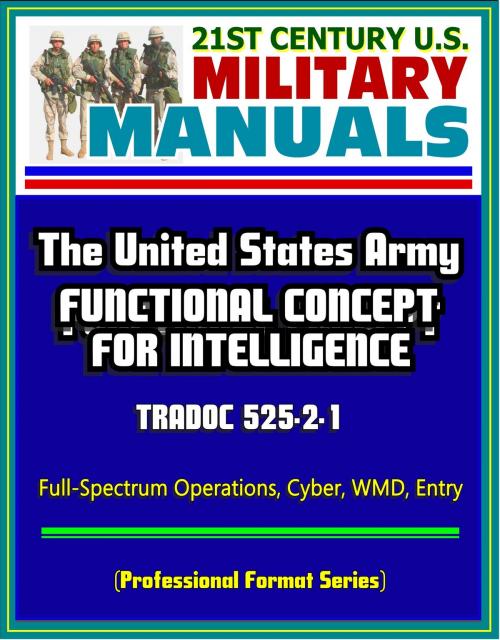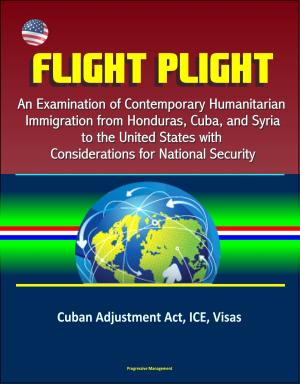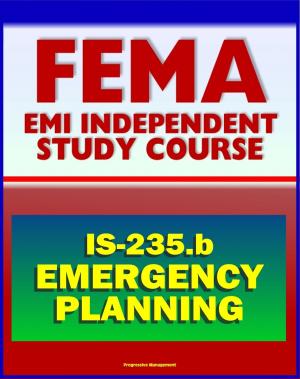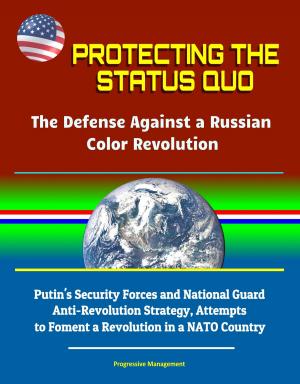21st Century U.S. Military Manuals: The United States Army Functional Concept for Intelligence - TRADOC 525-2-1, Full-Spectrum Operations, Cyber, WMD, Entry (Professional Format Series)
Nonfiction, History, Military, Strategy| Author: | Progressive Management | ISBN: | 9781301647644 |
| Publisher: | Progressive Management | Publication: | December 1, 2012 |
| Imprint: | Smashwords Edition | Language: | English |
| Author: | Progressive Management |
| ISBN: | 9781301647644 |
| Publisher: | Progressive Management |
| Publication: | December 1, 2012 |
| Imprint: | Smashwords Edition |
| Language: | English |
It serves as a foundation for future force development pertaining to intelligence and the intelligence warfighting function. In addition to the warfighting challenges of the future, the Army also faces a number of institutional challenges. The rapid pace of technological change, prolonged acquisition timelines, and growing resource constraints make it necessary for the Army to adopt a more responsive approach to capabilities development. Accordingly, TRADOC is shifting from a 5-year to a 2-year cycle for concept development and revision. As a result, the Army Capabilities Integration Center will update and revise the entire Army Concept Framework every 2 years. This significant change will enable more effective input into the major budget and programming decisions across our Army.
Chapter 1 * Introduction * 1-1. Purpose * 1-2. Background * 1-3. The operational environment * 1-4. The intelligence warfighting function * 1-5. Assumptions * 1-6. Linkage to the Army capstone concept * 1-7. Linkage to the AOC * 1-8. Linkage to the human dimension * 1-9. References * 1-10. Explanations of abbreviations and terms * Chapter 2 * Military Problem and Components of the Solution * 2-1. Military problem * 2-2. Solution synopsis * 2-3. Future force Army intelligence components of the solution * Chapter 3 * Core Operational Actions * 3-1. Introduction * 3-2. Conduct security force assistance * 3-3. Shaping and entry operations * 3-4. Intertheater and intratheater operational maneuver * 3-5. Full-spectrum operations * 3-6. Conduct overlapping protection operations * 3-7. Distributed support and sustainment * 3-8. Network-enabled mission command * Chapter 4 * Conclusion * 4-1. Summary * 4-2. Closing * Appendix A * References * Section I * Required Publications * Section II * Related Publications * Appendix B * Required Capabilities * B-1. ACC intelligence required capabilities * B-2. AOC intelligence required capabilities * B-3. First order required capabilities (what intelligence needs to do) * B-4. Second order: what intelligence needs from other warfighting functions * B-5. Other warfighting function dependencies on intelligence * B-6. Required capabilities to support rule of law outside the continental U.S. (OCONUS) * B-7. Support to IO required capabilities * B-8. Support to cyber operations required capabilities * B-9. Support to combating WMD required capabilities * Appendix C * Intelligence Echelons * C-1. Intelligence community * C-2. Division and above intelligence organizations * C-3. Army intelligence capabilities brigade and below * Appendix D * ARSOF Intelligence * D-1. Introduction * D-2. Intelligence structure * D-3. Military problem and intelligence * D-4. ARSOF lines of effort * D-5. ARSOF intelligence required capabilities and dependencies * Appendix E * Homeland Defense and Civil Support Intelligence * E-1. Introduction * E-2. Background * E-3. Operational Environment * E-4. Integrated theater Army intelligence enterprise mission * E-5. Concept of operations * E-6. Required capabilities
As a bonus, this reproduction includes the complete 2012 Army Leadership manual (FM 6-22), which describes the Army's view of leadership, outlines the levels of leadership (direct, organizational, and strategic), and describes the attributes and core leader competencies across all levels.
It serves as a foundation for future force development pertaining to intelligence and the intelligence warfighting function. In addition to the warfighting challenges of the future, the Army also faces a number of institutional challenges. The rapid pace of technological change, prolonged acquisition timelines, and growing resource constraints make it necessary for the Army to adopt a more responsive approach to capabilities development. Accordingly, TRADOC is shifting from a 5-year to a 2-year cycle for concept development and revision. As a result, the Army Capabilities Integration Center will update and revise the entire Army Concept Framework every 2 years. This significant change will enable more effective input into the major budget and programming decisions across our Army.
Chapter 1 * Introduction * 1-1. Purpose * 1-2. Background * 1-3. The operational environment * 1-4. The intelligence warfighting function * 1-5. Assumptions * 1-6. Linkage to the Army capstone concept * 1-7. Linkage to the AOC * 1-8. Linkage to the human dimension * 1-9. References * 1-10. Explanations of abbreviations and terms * Chapter 2 * Military Problem and Components of the Solution * 2-1. Military problem * 2-2. Solution synopsis * 2-3. Future force Army intelligence components of the solution * Chapter 3 * Core Operational Actions * 3-1. Introduction * 3-2. Conduct security force assistance * 3-3. Shaping and entry operations * 3-4. Intertheater and intratheater operational maneuver * 3-5. Full-spectrum operations * 3-6. Conduct overlapping protection operations * 3-7. Distributed support and sustainment * 3-8. Network-enabled mission command * Chapter 4 * Conclusion * 4-1. Summary * 4-2. Closing * Appendix A * References * Section I * Required Publications * Section II * Related Publications * Appendix B * Required Capabilities * B-1. ACC intelligence required capabilities * B-2. AOC intelligence required capabilities * B-3. First order required capabilities (what intelligence needs to do) * B-4. Second order: what intelligence needs from other warfighting functions * B-5. Other warfighting function dependencies on intelligence * B-6. Required capabilities to support rule of law outside the continental U.S. (OCONUS) * B-7. Support to IO required capabilities * B-8. Support to cyber operations required capabilities * B-9. Support to combating WMD required capabilities * Appendix C * Intelligence Echelons * C-1. Intelligence community * C-2. Division and above intelligence organizations * C-3. Army intelligence capabilities brigade and below * Appendix D * ARSOF Intelligence * D-1. Introduction * D-2. Intelligence structure * D-3. Military problem and intelligence * D-4. ARSOF lines of effort * D-5. ARSOF intelligence required capabilities and dependencies * Appendix E * Homeland Defense and Civil Support Intelligence * E-1. Introduction * E-2. Background * E-3. Operational Environment * E-4. Integrated theater Army intelligence enterprise mission * E-5. Concept of operations * E-6. Required capabilities
As a bonus, this reproduction includes the complete 2012 Army Leadership manual (FM 6-22), which describes the Army's view of leadership, outlines the levels of leadership (direct, organizational, and strategic), and describes the attributes and core leader competencies across all levels.















